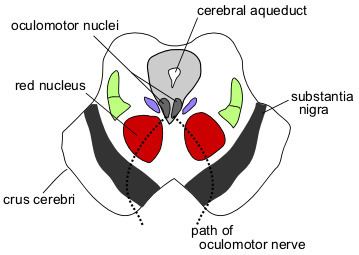NeuroNames hier-500 FMA 78467 | NeuroLex ID Cerebral aqueduct | |
 | ||
Latin aqueductus mesencephali (cerebri).
aqueductus Sylvii MeSH A08.186.211.132.659.822.187 | ||
The cerebral aqueduct, also known as the aqueductus mesencephali, mesencephalic duct, sylvian aqueduct or the aqueduct of Sylvius is within the mesencephalon (or midbrain), contains cerebrospinal fluid (CSF), and connects the third ventricle in the diencephalon to the fourth ventricle within the region of the mesencephalon and metencephalon, located dorsal to the pons and ventral to the cerebellum.
Contents
Development
The cerebral aqueduct, as other parts of the ventricular system of the brain, develops from the central canal of the neural tube, and it originates from the portion of the neural tube that is present in the developing mesencephalon, hence the name "mesencephalic duct."
Function
The aqueduct functions to connect the third and fourth ventricles and to ensure the flow of cerebrospinal fluid through these areas.
Clinical significance
Aqueductal stenosis, a narrowing of the cerebral aqueduct, obstructs the flow of CSF and has been associated with non-communicating hydrocephalus. Such narrowing can be congenital, arise via tumor compression, or through cyclical gliosis secondary to an initial partial obstruction.
